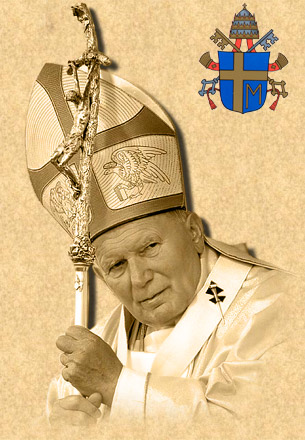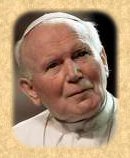 Pope John Paul
II
Pope John Paul
II|
|
 Ioannes Paulus PP. II Karol Wojtyla 16.X.1978 - 2.IV.2005 Pope John Paul II May 18 1920 - April 02 2005
|
|
The Lord is my shepherd, I
shall not want.
|
|||||||||||
|
|
 History: Karol Józef Wojtyla, known as John Paul II
since his October 1978 election to the papacy, was born in Wadowice, a small
city 50 kilometres from Cracow, on May 18, 1920. He was the second of two sons
born to Karol Wojtyla and Emilia Kaczorowska. His mother died in 1929. His
eldest brother Edmund, a doctor, died in 1932 and his father, a non-commissioned
army officer died in 1941. History: Karol Józef Wojtyla, known as John Paul II
since his October 1978 election to the papacy, was born in Wadowice, a small
city 50 kilometres from Cracow, on May 18, 1920. He was the second of two sons
born to Karol Wojtyla and Emilia Kaczorowska. His mother died in 1929. His
eldest brother Edmund, a doctor, died in 1932 and his father, a non-commissioned
army officer died in 1941.He made his First Holy Communion at age 9 and was confirmed at 18. Upon graduation from Marcin Wadowita high school in Wadowice, he enrolled in Cracow's Jagiellonian University in 1938 and in a school for drama. In 1942, aware of his call to the priesthood, he began courses in the clandestine seminary of Cracow, run by Cardinal Adam Stefan Sapieha, archbishop of Cracow. At the same time, Karol Wojtyla was one of the pioneers of the "Rhapsodic Theatre," also clandestine. After the Second World War, he continued his studies in the major seminary of Cracow, once it had re-opened, and in the faculty of theology of the Jagiellonian University, until his priestly ordination in Cracow on November 1, 1946.
In
1948 he returned to Poland and was vicar of various parishes in Cracow as well
as chaplain for the university students until 1951, when he took up again his
studies on philosophy and theology. In 1953 he defended a thesis on "evaluation
of the possibility of founding a Catholic ethic on the ethical system of Max
Scheler" at Lublin Catholic University. Later he became professor of moral
theology and social ethics in the major seminary of Cracow and in the Faculty of
Theology of Lublin.
John Paul II has presided at 147 beatification ceremonies (1,338 Blessed proclaimed) and 51 canonization ceremonies (482 Saints) during his pontificate. He has held 9 consistories in which he created 231 (+ 1 in pectore) cardinals. He has also convened six plenary meetings of the College of Cardinals. From 1978 to today the Holy Father has presided at 15 Synods of Bishops: six ordinary (1980, 1983, 1987, 1990, 1994, 2001), one extraordinary (1985) and eight special (1980, 1991, 1994, 1995, 1997, 1998[2] and 1999). No other Pope has encountered so many individuals like John
Paul II: to date, more than 17,600,000 pilgrims have participated in the
General Audiences held on Wednesdays (more than 1,160). Such figure is
without counting all other special audiences and religious ceremonies held [more
than 8 million pilgrims during the Great Jubilee of the Year 2000 alone] and the
millions of faithful met during pastoral visits made in Italy and throughout the
world. It must also be remembered the numerous government personalities
encountered during Pope John Paul will always be remembered as great man and
leader, not only to the Catholic church but to the world. He will be
greatly missed and always remembered. No one else has done so much to save
our world.
•
Paying respects - Catholics pay their
respects as they view the body of Pope John Paul II.
•
Final farewell -
Hundred of thousands
attend Mass in St. Peter's Square for Pope John Paul II.
•
Mourning the pope - The faithful of the world
remember the leader of the Catholic church in the days
immediately after his death.
•
In their thoughts - As Pope John Paul II lay in
his apartment, surrounded by his staff, the faithful
pray for his health.
Pilgrims knelt before the grave to pray, and many handed religious articles to an usher, who touched them to the grave before handing them back. Ushers kept the crowd moving, even hurrying along some people kneeled in prayer. The tomb sits alone in an arched alcove to the right of the main altar of the central nave, a leafy potted lily behind it and a small red candle burning at its front. A marble relief of the Madonna and Child hangs on the wall above. A rectangular white slab of marble with gray streaks marks the grave. On one line it bears his name carved with gold in Latin script: “IOANNES PAVLVS PPII.” And on another line are the dates of his 26-year pontificate using the Roman numerals for the month: “16 X, 1978-2 IV, 2005.” Underneath is the interlocking X and P — the monogram for Christ. |
||||||||||
|
Links to the Vatican:
Background, Biography and Main image Courtesy of The Vatican